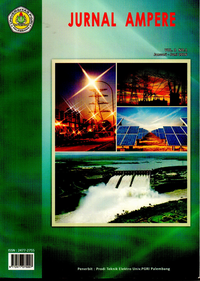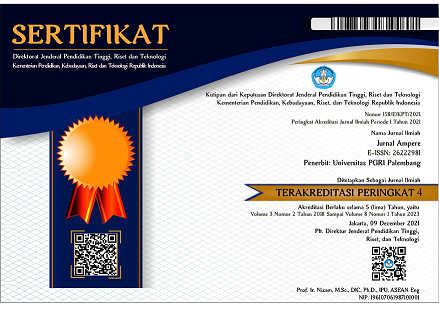ANALISA MODEL PROPAGASI OKUMURA-HATA DAN COST-HATA PADA KOMUNIKASI JARINGAN WIRELESS 4G LTE
DOI:
https://doi.org/10.31851/ampere.v5i1.4158Keywords:
Path loss, Propagasi, Okumura-Hata, COST-HataAbstract
Propagasi radio memilki peranan yang sangat penting dalam perkembangan jaringan telekomunikasi. Sinyal yang ditransmisikan oleh pengirim ke penerima mengalami redaman yang mengurangi kuat sinyal pada sisi penerima. Redaman yang terjadi pada saat perambatan gelombang di sebabkan oleh Large Scale Fading yang disebabkan oleh pengaruh benda dan bangunan yang ada disekitarnya. Penelitian ini bertujuan untuk membandingkan karakteristik path loss propagasi terhadap beberapa parameter yang ada pada sisi pengiriman maupun penerima serta membandingkan model propagasi large scale yang digunakan saat ini dalam jaringan LTE (Long Term Evolution). Simulasi dilakukan dengan dengan menggunakan Model propagasi Okumura-Hata dan Cost-231 Hata serta menganalisa pengaruh path loss berdasarkan perubahan frekuensi, ketinggian BTS dan juga perbedaan karakteristik wilayah yaitu urban, sub-urban dan rural. Hasil dari penelitian menunjukkan bahwa pada pemodelan Okumura-Hata dan Cost-Hata mempunyai profil path loss yang hampir saya yaitu penggunaan frekuensi yang semakin tinggi, path loss yang dihasilkan semakin besar. Begitu juga dengan ketinggian antenna pemancar, semakin tinggi antenna pengirim maka path loss yang dihasilkan semakin kecil. Dari sisi karakteritik wilayah meunjukkan bahwa path loss yang dihasilkan pada daerah urban lebih tinggi dibandingkan dengan daerah sub-urban maupun rural area dikarenakan wilayah urban memiliki struktur bangunan yang lebih tinggi dan padat.References
H. K. Hoomod, I. Al-Mejibli, and A. I. Jabboory, “Analyzing Study of Path loss Propagation Models in Wireless Communications at 0.8 GHz,†J. Phys. Conf. Ser., vol. 1003, no. 1, pp. 1–8, 2018, doi: 10.1088/1742-6596/1003/1/012028.
O. F. Oseni, S. I. Popoola, R. O. Abolade, and O. A. Adegbola, “Comparative Analysis of Received Signal Strength Prediction Models for Radio Network Planning of GSM 900 MHz in Ilorin, Nigeria,†Int. J. Innov. Technol. Explor. Eng., no. 3, pp. 2278–3075, 2014.
Z. Nadir and M. I. Ahmad, “Pathloss determination using Okumura-Hata model and cubic regression for missing data for Oman,†in Proceedings of the International MultiConference of Engineers and Computer Scientists 2010, IMECS 2010, 2010, vol. II, no. 1, pp. 804–807.
K. O. Kadiri and O. A. Somoye, “Computer Simulation of Path Loss Characterization of a Wireless Propagation Model in Kwara State , Nigeria,†Int. J. Comput. Inf. Technol., vol. 3, no. 3, pp. 610–615, 2014.
A. Ekeocha, N. Onyebuchi, and A. Ifenyinwa, “Comparative Study of Path Loss Models for Wireless Communication in Urban and Sub-urban Environment for Port Harcourt, Nigeria,†Am. J. Eng. Res., vol. 4, no. 11, pp. 109–115, 2015.
B. Alfaresi, T. Barlian, F. Ardianto, and M. Hurairah, “Path Loss Propagation Evaluation and Modelling based ECC-Model in Lowland Area on 1800 MHz Frequency,†J. Robot. Control, vol. 1, no. 5, pp. 167–172, 2020, doi: 10.18196/jrc.1534.
O. Shoewu, S. O. Olatinwo, and D. D. Olatinwo, “Comparative Analysis of Pathloss in Metropolitan Domain in Nigeria using Okumura-Hata Model,†Eur. J. Sci. Res., vol. 141, no. 1, pp. 5–15, 2016.
O. P. Omolaye, G. A. Igwue, and G. A. Akpakwu, “OKUMURA-HATA : A PERFECT MODEL FOR DRIVING ROUTE UHF INVESTIGATION,†Am. J. Eng. Res. ( AJER ), vol. 4, no. 9, pp. 139–147, 2015.
B. Alfaresi, “Analisa Indikator Performansi Jaringan 4G LTE (Long Term Evolution) Frekuensi 1800 MHz terhadap Perubahan Jarak e-NodeB di Daerah Urban,†J. Surya Energi, vol. 1, no. 2, pp. 60–70, 2017.
O. I. Adu, F. E. Idachaba, and A. A. Alatishe, “Refarming 1800MHz GSM spectrum to LTE: He effects on coverage based on pathloss estimation,†Lect. Notes Eng. Comput. Sci., vol. 1, pp. 673–676, 2014.
Downloads
Published
How to Cite
Issue
Section
License

Jurnal Ampere is licensed under a Creative Commons Attribution-ShareAlike 4.0 International License.
Authors who publish with this journal agree to the following terms:
- Authors retain copyright and grant the journal right of first publication with the work simultaneously licensed under a Creative Commons Attribution License that allows others to share the work with an acknowledgement of the work's authorship and initial publication in this journal.
- Authors are able to enter into separate, additional contractual arrangements for the non-exclusive distribution of the journal's published version of the work (e.g., post it to an institutional repository or publish it in a book), with an acknowledgement of its initial publication in this journal.
- Authors are permitted and encouraged to post their work online (e.g., in institutional repositories or on their website) prior to and during the submission process, as it can lead to productive exchanges, as well as earlier and greater citation of published work.






